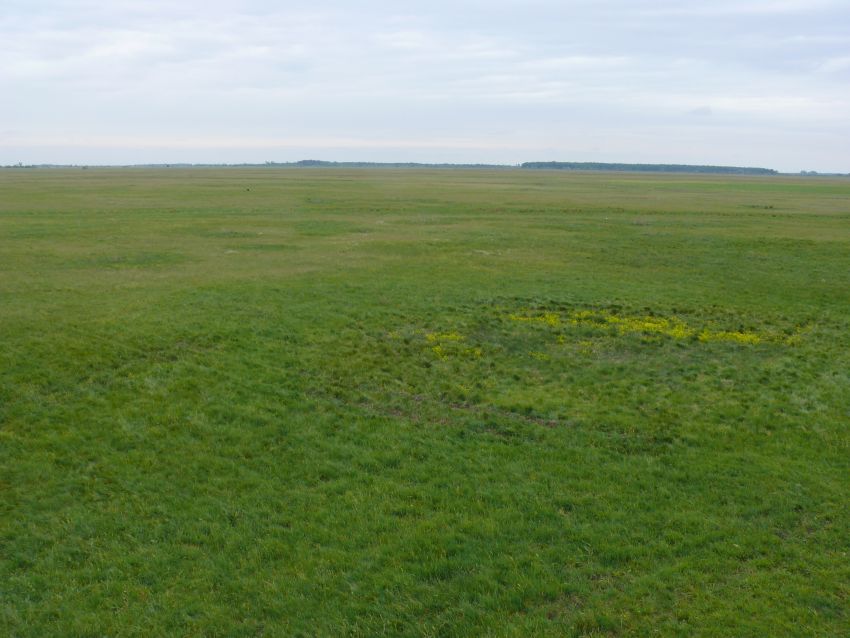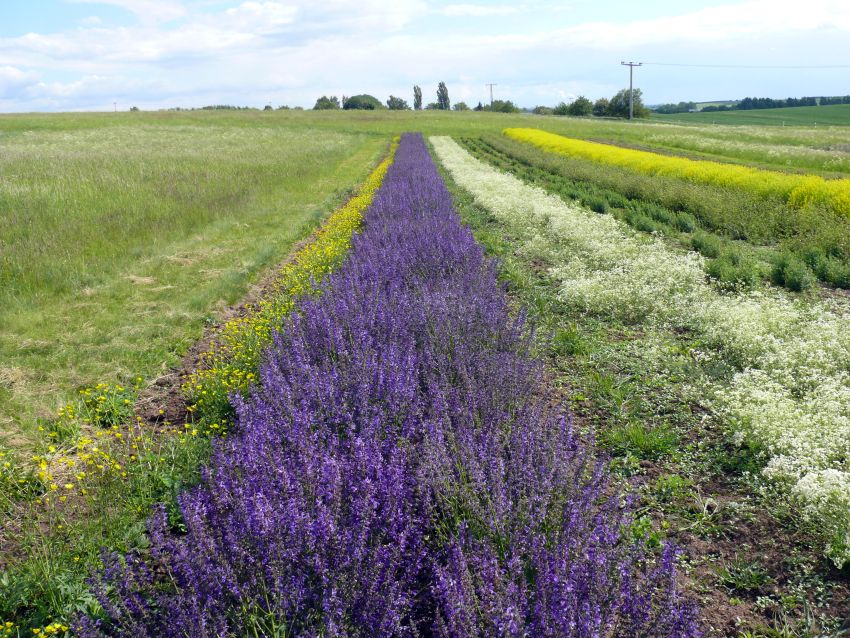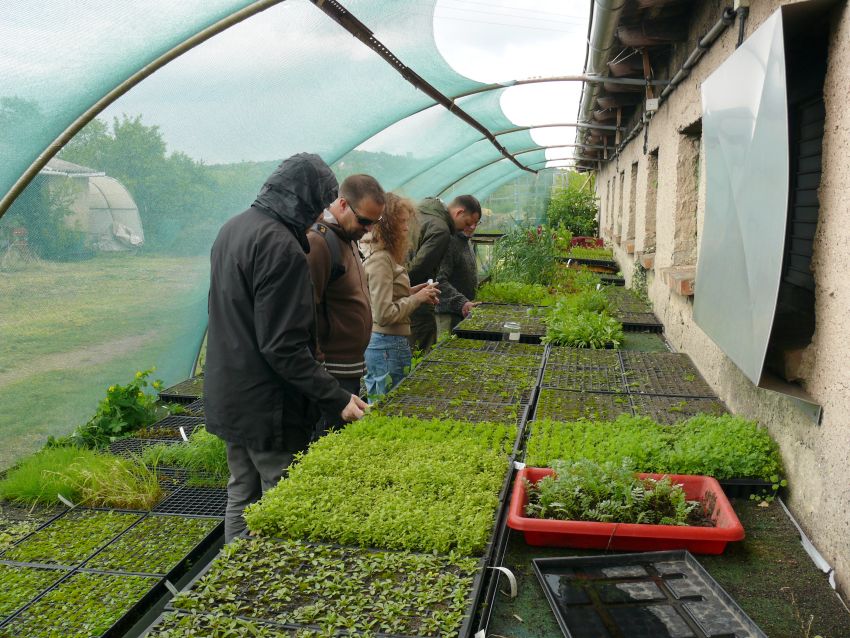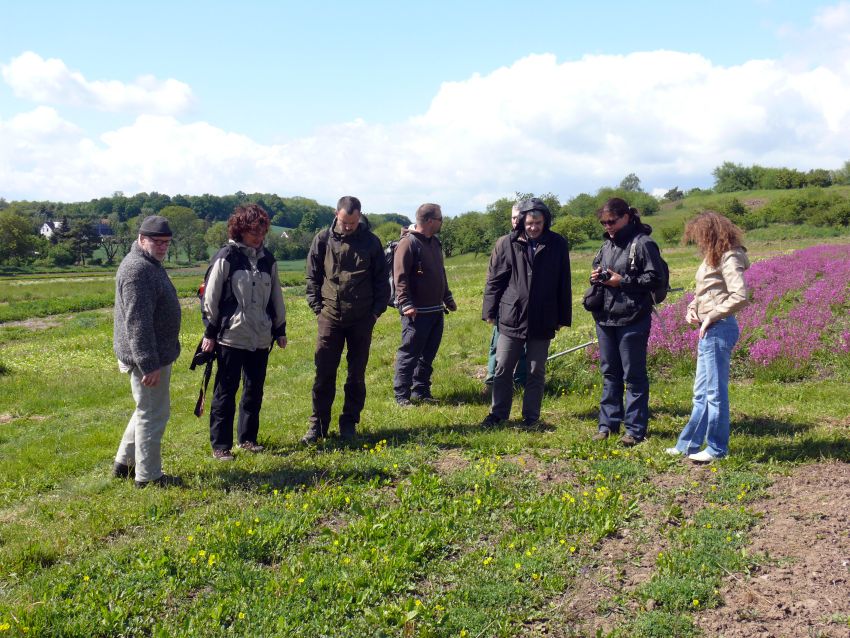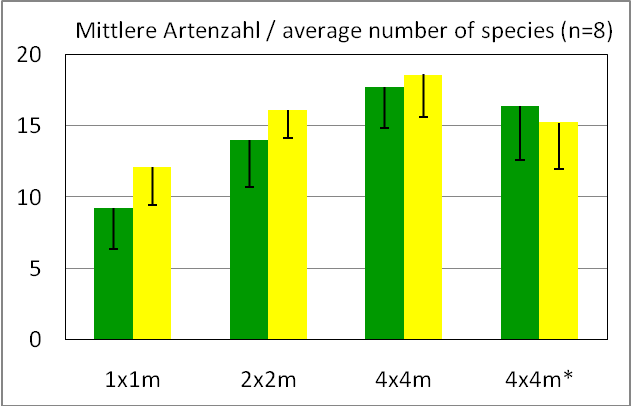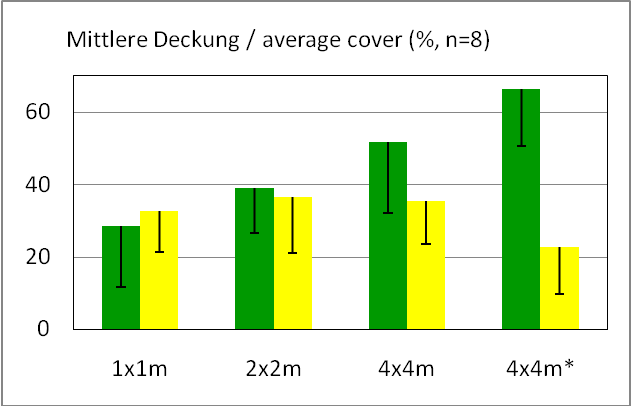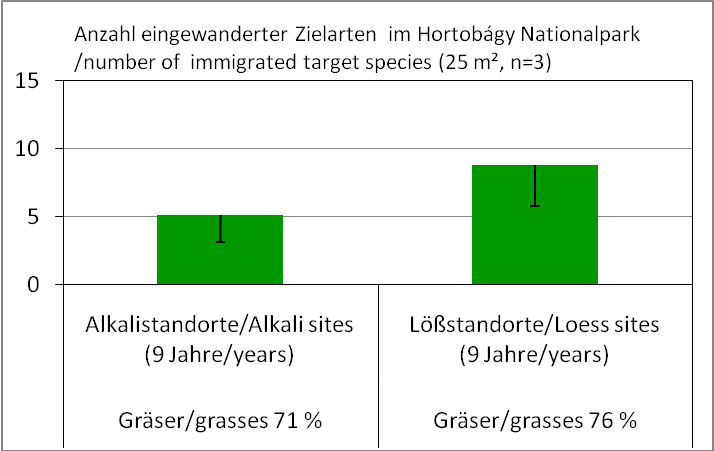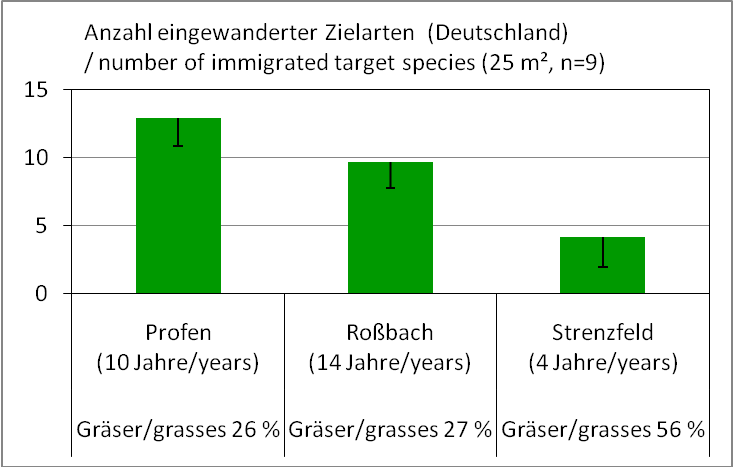Large-scale grassland restoration: the use of establishment windows and high diversity seeding by the knowledge transfer of regional seed propagation to Hungary
Motivation of the project
Motivation of the project

Project site Hortobágy national park. Within this project, a cooperation of Hungarian and German partners intended to develop an innovative concept in creating species-rich grasslands (Festucion pseudovinae Soó 1933, Festucion rupicolae Pop 1968) on former arable lands in the Hortobágy National Park by using a two-phased restoration approach that is especially suitable for large-scale restoration sites. In the first step, emergence of arable weeds was hampered by sowing of a species-poor seed mixture of competitive grasses. In the second step, species-rich target forb seed mixtures will be sown in so-called establishment windows, which serve as seed sources. At the moment, there are open questions concerning the size of the establishment windows and the influence of grazing on the establishment rate and seed production of sown species.
The Hortobágy National Park was chosen as a model region. Between 2005 and 2008, a low-diversity mixture of 2-3 regional native grasses were sown on 760 ha of former arable land because seed of other native species were not available at that time. The lack of appropriate seed sources of target species in the region prevented a spontaneous immigration of target species till today. Therefore, these sites offer the unique opportunity to test the two-phased restoration approach on a larger scale. Afterwards, this concept can be used to restore more species-rich grasslands on arable lands in the Hortobágy National Park and even in a broader scale. In general, this method can be transferred to other vegetation types dealing with edaphic or climatic drought stress within and outside Hungary.
In Hungary, seed of regional wild plants are not available commercially till now. Therefore, the project consortium is helping the Salvia Environmental and Nature Protection Association to start seed propagation to produce a regional seed source of herbaceous grassland plants available for future restoration projects. In addition, the project helps to establish a donor site register of the Hortobágy National Park to locate species-rich alkali and loess grasslands in order to facilitate the search for sites suitable for the collection of basis seed material for propagation and to ensure that these sites are kept in a good conservation status.
Work package 1: Seed propagation of wild plants
Work package 1: Seed propagation of wild plants

Trays with juvenile plants of selected target species grown in greenhouses, 
planting in rows, 
and prepared propagation site in Hungary in October 2014. Seed propagation of wild plants is a difficult task. Different species have specific requirements for germination, growing, harvesting, cleaning and storing. Seed producers have to be resourceful and innovative to cope with drawbacks caused by climate, pests, and lack of knowledge about wild plant reproduction. In Germany, there are already some regional seed companies producing and selling regional seeds of c. 450 wild plants for different German seed zones. Conversely, in Hungary, even regionally produced seeds of common grasses are unavailable.
Supported by a German seed producer, the project team selected target plant species suitable for agricultural propagation and restoration, compiling their specific requirements for germination, establishment, seed harvest and processing. During a project workshop in Bernburg in May 2014, the Hungarian team had the opportunity to become acquainted with the whole process of agricultural propagation of wild seed. During the yearly meeting of the German Association of Wild Seed and Plant Producers, they were able to discuss open questions with the members.
Beginning in September 2013, parent seed material was collected in the Hortobágy National Park and in spring 2014, seed were sown in a greenhouse. Supported by the National Park administration, the Salvia Environmental and Nature Protection Association selected suitable sites for agricultural seed propagation. Between September and mid of October 2014, the following target species were planted or sown on arable land with an extension of 50 m x 50 m:
- Achillea collina (30 individuals + sowing)
- Agropyron pectinatum (only sowing)
- Centaurea sadleriana (200 individ. + sowing)
- Dianthus pontederae (300 individuals + sowing)
- Festuca pseudovina (only seed sowing)
- Filipendula vulgaris (600 individuals + sowing)
- Hypericum perforatum (50 individuals + sowing)
- Melandrium viscosum (70 individuals + sowing)
- Phlomis tuberosa (210 individuals + sowing)
- Salvia austriaca (290 individuals + sowing)
- Salvia nemorosa (300 individuals + sowing)
- Silene vulgaris (30 individuals + sowing)
To motivate farmers in the project area to take up the task of wild seed propagation, an information brochure about the basics of wild seed propagation will be compiled in Hungarian and English language. We want to raise the awareness, that seed production of regional ecotypes should be exclusively done in the concerned region, thus avoiding hybridization with foreign and non-local ecotypes. At the end of the project, a regional workshop will be organized by the Debrecen University.
Work package 2: Web-based donor site registers for species-rich grasslands
Work package 2: Web-based donor site registers for species-rich grasslands
In the Hortobágy region, the area of former species-rich grasslands decreased. Most locations of the remaining species-rich loess grasslands are managed by the Hortobágy National Park Administration.
Especially in regions, where pristine grasslands have become scarce, a data base about still existing grasslands is extremely useful. The data base of potential donor sites will encompass ecological as well as economical data. The knowledge about valuable donor sites will support their proper management. According to prior agreement with the Hortobágy National Park Administration, these sites can be used for the collection of basis seed for seed propagation in frame of the project but also for small-scale on-site harvesting via threshing, mowing, or raking.
Work package 3: Establishment windows
Work package 3: Establishment windows
In the Hortobágy National Park, in October 2013, 32 establishment windows were established on four potential alkali sites and four loess sites: 16 x 4 m² (8 fenced, 8 unfenced), 8 x 2 m², 8 x 1 m². The distances between sites were at least 50 m. After tilling and seed bed preparation, the windows were sown with 35 regionally collected target species with a seed density of 10 g/m². The selected target species are characteristic for the target vegetation types: Festucion pseudovinae Soo 1933 and Festucion rupicolae Pop 1968. Since the whole study area is covered by loess loam and differences in salt content are only in the deeper soil layers, only one seed mixture was sown. Dependent on the salt tolerance of the sown species, mosaic stands of both vegetation types will develop with ongoing time, accordingly to the gradual effect of the capillary rise of salty water from below-ground.
Our study focuses on the following questions:
(1) is tilling positive for the establishment of target species,
(2), which size of establishment windows is best for the establishment and dispersal of sown target species, and
(3) how influences the management regime (with/without grazing) the establishment rate and seed production of sown species.
To follow the question, which factors are decisive for the successful colonization of species-poor sites, we studied the migration rate of target species into control sites without species introduction in old restoration sites in Germany and Hungary. In summer 2014, we documented number and cover of immigrated target species, migrating from adjacent sites with species introduction on 5 m x 5 m permanent plots without species introduction.
First results
First results

Mean number of species in June 2014; green = types of seed, yellow = spontaneous types, * = fenced areas. 
Medium cover in June 2014; green = types of seed, yellow = spontaneous types, * = fenced areas. Establishment windows
In the first year, 33 out of 35 sown species were found on all establishment windows in the Hortobágy National Park. Separated in different window sizes the following establishment rates were reached: 1 m² 66 %, 4 m² 86 %, 16 m² (unfenced) 89 %, 16 m² (fenced) 80 %.
On the 16 m² establishment windows, sown target species reached the highest mean species numbers and the highest mean cover compared to 1 m² and 4 m² variants. On fenced sites, species numbers were slightly lower than on unfenced variants. In contrast, on fenced variants sown species reached the highest and spontaneously immigrated species the lowest cover compared to all other variants.
Immigration of target species
In the Hortobágy National Park, potential alkali and loess sites were sown with 2 or 3 regional grasses 9 years ago. By 2014, on average, more target species had established themselves on loess surfaces than on alkali surfaces due to the lower salt content. The sown grasses still dominate at both locations.
3 locations were investigated in Germany: (1) Strenzfeld grass border, (2) sown embankment (3 cultivated grasses) Profen opencast mine, (3) Roßbach opencast mine embankment greened over spontaneous succession. Here the number of immigrated target species shows a clear correlation with the age of the area and the grass cover.

Target species immigrated after 9 years. 
Immigrated target species in old renaturation areas.
Lead partner: Anhalt University of Applied Sciences, Prof. Dr. habil. Sabine Tischew
Researcher: Dr. Anita Kirmer
Funded by: Deutsche Bundesstiftung Umwelt
Project partner: University of Debrecen, Department of Ecology, Biodiversity and Ecosystem Services Research Group, Prof. Dr. Béla Tóthmérész
Cooperation partners: SAALESAATEN - Begrünungsberatung, Wildpflanzenvermehrung und -handel, Dipl.-Ing. agr. Matthias Stolle, Hortobágy National Park Directorate, Salvia Environmental and Nature Protection Association




